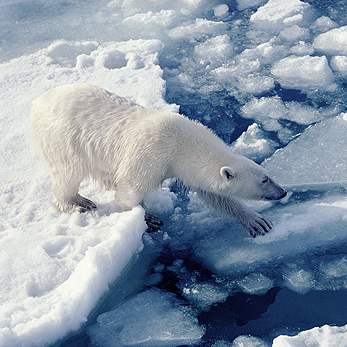Drastic reductions in greenhouse gas emissions are key to mitigating impacts
The UN Framework Convention on Climate Change leads work at the global level towards stabilising greenhouse gas concentrations in the atmosphere at a level that would prevent dangerous anthropogenic interference with the climate system. In this context the Kyoto Treaty has committed most industrialised nations to legally binding reductions in greenhouse gas emissions by 2008–2012. Negotiation of a post-2012 framework was initiated by the Copenhagen Conference of the Parties in December 2009.
More than 5000 million tonnes CO2 equivalent of greenhouse gases were emitted in Europe in 2007. This is 9.3% less than in 1990. Global greenhouse gas emissions must be reduced to less than 50% of 1990 levels by 2050 if the rise in average global temperature is to be kept below 2°C compared to pre-industrial levels, and specifically, reductions in CO2 are required to mitigate consequences of ocean acidification. The EU has set a binding unilateral interim target to cut greenhouse gas emissions by 20% over the period 2012–2020 and aims to increase the share of renewable energies in Europe to 20% over this period. Urgent action is needed to achieve these targets, employing a wide range of solutions. Options include improving energy efficiency, reducing energy demand, shifting to renewable energies and carbon capture and storage. All options, whether on land or at sea, can be expected to change the distribution and intensity of pressures on the marine environment.
Demand for energy from wind, waves and tides is increasing
Most of the existing and planned offshore renewable energy projects are wind farms concentrated in Regions II and III. The number of offshore wind farms in the OSPAR area has grown substantially over the past ten years and if all farms authorised and applied for in 2009 are developed, the number of offshore turbines in the OSPAR area will increase almost tenfold Chapter 9. More applications have been made and more are expected. In some areas there is potential for harnessing energy from waves, tidal streams and salinity gradients. Commercial-scale development is currently limited.
Wave and tidal power test sites have been operating off Ireland and Scotland for several years, with 0.3 GW total installed capacity in 2008. It will probably be some years before there is large-scale marine energy generation in the OSPAR area, although some countries have set targets for tidal stream and wave energy production. For example, Scotland plans to install 1.3 GW of capacity by 2020. The environmental impacts of these techniques and the necessary mitigating measures are likely to vary depending on the technology and location. Increasing demand for renewable energy from the marine environment suggests that regional cooperation and marine spatial planning could be important tools for managing the competition for space in coastal and offshore areas and for minimising their impacts on the marine environment.
Carbon sequestration can help the transition to a lower carbon economy
Capturing carbon from combustion at source and transporting this to sub-seabed geological reservoirs could help mitigate climate change over century-long time scales and thus help with the transition to a lower carbon economy. Eligible reservoirs include depleted oil and gas fields in the North Sea (Region II) and the Norwegian Sea (Region I). OSPAR and the EU have developed frameworks for managing the risks from carbon sequestration. The main risks to the environment and human health include a risk of re-emitting stored CO2 to the atmosphere, and local risks from possible releases of CO2 and other substances in the CO2 stream to the marine environment. Three projects are currently operating in the OSPAR area, of these the Sleipner project provides the longest experience. Good site selection, project design based on risk assessments, and monitoring are essential for avoiding CO2 leakage and reducing environmental impacts.

